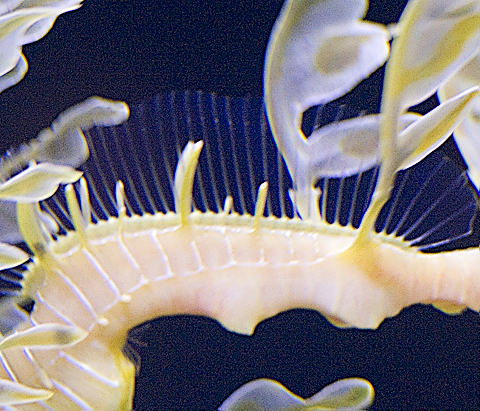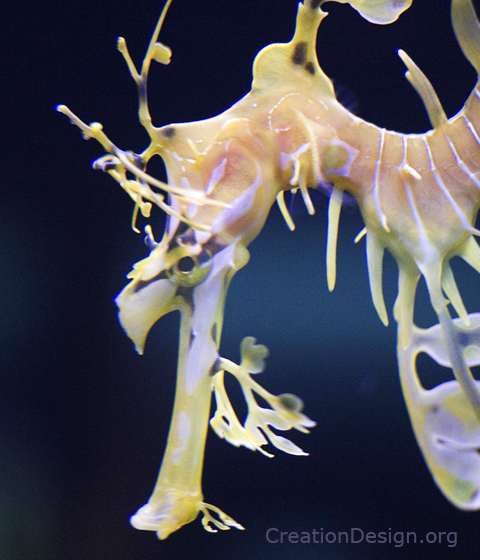Australian Leafy Sea Dragon

For many people the unmatched perfection of camouflage is the most obvious example of a life form that could never have evolved. The reason for this is that where an organism as delicate as the Australian Leafy Sea Dragon (a seahorse) is forced to rely upon camouflage for survival, how could more "primitive" imperfectly camouflaged creatures ever have survived? That is, if camouflage is all it has, how could it develop the camouflage through random mutations over thousands of years?
The Australian Leafy Sea Dragon has absolutely no means of protection from its predators other than its spectacular camouflage. It has no poison, no speed, no mouth, no threat - nothing but is camouflage. And the leaves of its camouflage have no function other than camouflage.

This creature glides through the water; nothing on its body appears to move. Its only means of propulsion is a transparent dorsal fin that is practically invisible.

The dorsal fin moves the body by a silent undulation. It does not flap.

This delicate creature seems to have been drawn by an artist. Even the eyes are camouflaged consistently with the markings on the face.
So, if it had to develop camouflage to escape its predators, how could it do so when prior to the development of its camouflage it had no chance of survival whatever? The only answer is that it did not evolve. Australian Leafy Sea Dragons have always been Leafy Sea Dragons and the Creator is indeed an artist.
A second fascinating attribute given by the Creator to seahorses is its vertebrae. The spinal column of the seahorse extends down through the vertebrae in its tail. Its tail is extremely important to its survival because it is used to anchor the seahorse to stationary objects underwater such as rocks or coral and thereby feed or conceal itself. The verterbrae in the seahorse are singular in that they are not simply vertebral bones stacked one upon another, as in mammals. In the seahorse, each vertebra is not one but four bones, each one forming a corner with overlapping sides that are made to slide rather than break. The result is that when bitten, the seahorse's backbone collapses on itself and does not break. The seahorse survives and keeps its tail, as well as its spinal column. This fact has been utilized by the Jacobs School of Entineering at the University of California at San Diego and inspired a study directed toward the invention of a new, stronger, lighter and more flexible armor. See http://www.jacobsschool.ucsd.edu/news/news_releases/release.sfe?id=1358. The minute vertabrae are clearly structured for this purpose. The sides that slide over one another are angulated so that they never lock, they contain tiny guides to ensure that the slides of all of the sides are even and straight. Further, the vertebrae contain tiny joints that similar to ball and socket joints to permit the vertebrae to pivot as well as slide. The study referenced above tells of these wonders.